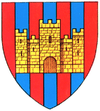Ținutul Suceava
| Ținutul Suceava | ||
|---|---|---|
| Land (Ținut) | ||
| ||
 | ||
| Country |
| |
| Former counties included | Câmpulung County, Cernăuți County, Dorohoi County, Hotin County, Rădăuți County, Suceava County, Storojineț County | |
| Historic region | Moldavia (Bessarabia Bukovina Hertza) | |
| Capital city (Reședință de ținut) | Cernăuți | |
| Established | The administrative reform of 1938 | |
| Cesed to exist | Territorial loss and new administrative law (26–28 June 1940) | |
| Government | ||
| • Type | Rezident Regal | |
| Time zone | EET (UTC+2) | |
| • Summer (DST) | EEST (UTC+3) | |
Ținutul Suceava was one of the ten Romanian ținuturi ("lands"), founded in 1938 after King Carol II initiated an institutional reform by modifying the 1923 Constitution and the law of territorial administration. Including most of Bukovina and a section of northern Bessarabia, it was named after the city of Suceava; its capital was the city of Cernăuți. Ținutul Suceava ceased to exist following the territorial losses of Romania to the Soviet Union and the king's abdication in 1940.
Coat of arms
The Coat of Arms consists of seven pallets, four of gules and three of azure, representing the former seven counties (județe) of Greater Romania which it included (of the total 71). Over the pallets there is a castle, representing the medieval citadel in Suceava.
Former counties incorporated
After the 1938 Administrative and Constitutional Reform, the older 71 counties lost their authority.
- Câmpulung County
- Cernăuți County
- Dorohoi County
- Hotin County
- Rădăuți County
- Suceava County
- Storojineț County
See also
- Historical administrative divisions of Romania
- Chernivtsi Oblast
- Nord-Est (development region)
- History of Romania
- History of Ukraine
